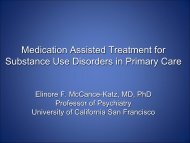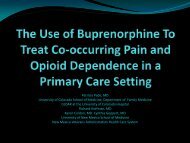Treatment of Complex and High Risk Chronic Pain - American ...
Treatment of Complex and High Risk Chronic Pain - American ...
Treatment of Complex and High Risk Chronic Pain - American ...
- No tags were found...
You also want an ePaper? Increase the reach of your titles
YUMPU automatically turns print PDFs into web optimized ePapers that Google loves.
Carolyn Buesgens, MA, RN-BC, ANP-BCMinneapolis VAHCS1
Objectives1. Define factors contributing to increasedcomplexity <strong>and</strong> risk in patients with chronic pain2. Explain the limitation <strong>of</strong> opioids as unimodaltherapy for chronic pain3. Describe a multimodal rehabilitation approach inaddressing factors <strong>of</strong> high risk or complexchronic pain2
• Biological components• Psychological components• Social components4
• 41year-old man with chronic low back pain• s/p lumbar epidural spinal injections <strong>and</strong> lumbar fusion• 2011 EMG: No evidence <strong>of</strong> peripheral neuropathy <strong>of</strong> the LE• Past history <strong>of</strong> Valium overdose <strong>and</strong> suicide attempts.• Positive family hx substance abuse• Mental health diagnoses: depression, anxiety disorder, opioid <strong>and</strong> alcoholdependence, mood disorder r/t medical condition.• Poor activity tolerance on Methadone 90 mg daily (limited st<strong>and</strong>ing <strong>and</strong>sitting)• Left his job two years ago• Adjuvant medications: gabapentin, cyclobenzaprine, venlafaxine.• Patient expressed desire to come <strong>of</strong>f Methadone• Non-pharmaceutical approaches: stress management classes, pain copingskills class, depression management skills, ACT classes.• Physical therapy “didn’t work”5
• substance abuse• addiction• medical comorbidities• number <strong>of</strong> pain complaints• past functional history• psychiatric issues• concomitant rx for sedative-hypnotics <strong>and</strong>/orhigh dose opioid6
• Recent estimates suggest that pain <strong>and</strong> depressivedisorder co-occur 30-60% <strong>of</strong> the time• Anxiety disorders may be present 35% <strong>of</strong> the timeamong person with chronic pain• <strong>Pain</strong> <strong>and</strong> PTSD co-occur; 20-34% <strong>of</strong> persons withchronic pain meet criteria for PTSD; chronic pain ispresent in 45-87% <strong>of</strong> persons with PTSD• <strong>Pain</strong> is present in 37-61% <strong>of</strong> patients seeking substanceuse disorders treatment.• <strong>Pain</strong> undermines effective treatment for depression,anxiety disorders, PTSD, <strong>and</strong> substance use disorders.7
• When disability greatly exceeds what would beexpected on the basis <strong>of</strong> physical findings alone,• When patients make excessive dem<strong>and</strong>s on thehealth care system• When patients persist in seeking medical tests <strong>and</strong>treatments that are not indicated• When patients display significant emotionaldistress (e.g. depression or anxiety)• When patients display evidence <strong>of</strong> addictivebehaviors or continual non-adherence to theprescribed treatment regimen.• Adapted from Turk et al, 20108
• <strong>Complex</strong>-chronic pain does not respond to our usualtreatments (the “pain patients”)• Syndrome encompasses a wide variety <strong>of</strong> painful conditions• Pattern <strong>of</strong> declining function (in spite <strong>of</strong> progressively moreaggressive, expensive, <strong>and</strong> risky medical treatments• Unpleasant interactions.• Dissatisfied customers.• Medication adherence issues• Overwhelmed <strong>and</strong> overwhelmingIatrogenesis is a significant problem for this population!A. MarianoSeattle VA9
Kirsh,KL, Passik, S; ExpClin Psychopharm, 2008;16(5)10
• Not all patients are good c<strong>and</strong>idates for opioidtherapy• <strong>Risk</strong> stratification is helpful in directing acourse <strong>of</strong> treatment• Low-risk• Intermediate-risk• <strong>High</strong>-risk11
• Opioid <strong>Risk</strong> Tool (ORT)• Screener <strong>and</strong> Opioid Assessment for Patientswith <strong>Pain</strong> (SOAPP)• Drug Abuse Screening Test (DAST)• CAGE-AID• STARS/SISAP• Current Opioid Misuse Measure (COMM)12
Opioids are such a big part <strong>of</strong> the problem,principally, because they are such a small part<strong>of</strong> the solution.”Anthony Mariano, PhDSeattle VAMC13
• <strong>High</strong> dose opioid use occurred in 2.4% <strong>of</strong> all chronic pain patients <strong>and</strong> in8.2% <strong>of</strong> all chronic pain patients prescribed opioids long-term.• The average dose in high-dose group was 324.9 (SD=285.1)• The only significant demographic difference among groups was race w/black veterans less likely to receive high doses.• <strong>High</strong>-dose patients were more likely to have four or more pain diagnoses<strong>and</strong> the highest rates <strong>of</strong> medical, psychiatric, <strong>and</strong> substance use disorders.• After controlling for demographic factors <strong>and</strong> VA facility, neuropathylow back pain, <strong>and</strong> nicotine dependence diagnoses were associated w/increased likelihood <strong>of</strong> high-dose prescriptions.• <strong>High</strong> dose patients frequently did not receive care consistent w/treatment guidelines; There was frequent use <strong>of</strong> short-acting opioids,urine drug screens were administered to only 25.7% <strong>of</strong> patients in theprior year, <strong>and</strong> 32.% received concurrent benzodiazepine rx, which mayincrease risk for OD <strong>and</strong> death Morasco et al, 201014
Veterans with mental health diagnoses prescribedopioids, especially those with PTSD< weremore likely to have comorbid drug <strong>and</strong> alcoholuse disorders; receive higher-dose opioidregimens; continue taking opioids longer;receive concurrent prescriptions for opioids,sedative hypnotics, or both; <strong>and</strong> obtain earlyopioid refills.Seal et al, 201215
2012: A memor<strong>and</strong>um authored by the chief <strong>of</strong>staff launched the Opioid Safety Initiative limitingtotal daily opioid dose to < 200 MED16
• Bohnert et al. Association between opioidprescribing patterns <strong>and</strong> opioid overdoserelateddeaths. 2011. JAMA; 305: 1315-1321.• Dunn et al. Opioid prescriptions for chronicpain <strong>and</strong> overdose. 2010. Annals <strong>of</strong> InternalMedicine; 152: 85-92.• Gomes et al. Opioid dose <strong>and</strong> drug-relatedmortality in patients with nonmalignant pain.2010. Arch Int Med; 171;686-69317
2012o Primary Care Team training <strong>and</strong> educationo Pharmacists <strong>and</strong> clinical psychologists closelyaligned with each clinico A chronic pain consult service was beguno Patient <strong>Pain</strong> Education Class startedo Medicine Gr<strong>and</strong> Rounds highlightingavailable behavioral pain programso Tracking/performance measures18
Percent Reduction in Number <strong>of</strong> Patientsat 50+, 100+, 200+, 500+ <strong>and</strong> 1000+ MEQ/dayMinneapolis VA May 2011 - September 201210%0%-10%-20%-30%-40%-50%-60%-8%-19%-27%-44%-50%>50 MEQ>100 MEQ>200 MEQ>500 MEQ>1000 MEQ
Your patient does not have a right to opioids.They have a right to good care <strong>and</strong> appropriatetreatment <strong>and</strong> in some cases, withdrawing orwithholding opioids is ethically m<strong>and</strong>ated.A Mariano, PhDSeattle VAMC20
AssessmentIdentification <strong>of</strong> needs (<strong>and</strong> risk factors)<strong>Chronic</strong> <strong>Pain</strong> Care PlanAppropriate referralsOngoing EducationIndividualized follow-up/monitoring22
• Validation – much <strong>of</strong> the struggle withpatients relates to our communication <strong>of</strong> doubt• Education – the basis <strong>of</strong> effective long termcare is a shared underst<strong>and</strong>ing <strong>of</strong> chronic pain• Motivation – patients vary in their willingnessto engage in self management• Activation – primary clinical focus is onchanging the way patients relate to painMariano, PhDSeattle VA24
• Shared by patients who are overwhelmed by pain<strong>and</strong> providers who find these peopleoverwhelming:• Belief that objective evidence <strong>of</strong> disease/injury isrequired for pain to be “real”• View <strong>of</strong> pain as the only problem, <strong>and</strong> which needs tobe avoided at all costs• Expectation that urgent pain relief is the major goal <strong>of</strong>treatment• Overconfidence in medical solutions• Provider is the “expert” responsible for outcomes• Patient is helpless “victim” <strong>of</strong> underlying disease/injuryA. MarianoSeattle VA 25
• Optimal treatment paradigm• Comprehensive assessment <strong>and</strong> individualizedtreatment plan• Offer hope <strong>and</strong> help patient connect with theirvalued life• End uncertainty26
“Treating a pain patient can be like fixing a car with four flattires. You cannot just inflate one tire <strong>and</strong> expect a good result.You must work on all four.”Penny Cowan, Executive Director<strong>American</strong> <strong>Chronic</strong> <strong>Pain</strong> Association27
• Supportive therapies• Cognitive-behavioral therapy• Re-conceptualizing <strong>of</strong> pain as problem to be solved• Coping skills training• Behavioral Interventions• Altering pain-related communication• Behavioral activation• Self-regulatory treatments• Bi<strong>of</strong>eedback• Relaxation training (progressive muscle relaxation;autogenic training)• Hypnosis28
Mindfulness based programs• ACT: Acceptance <strong>and</strong> Commitment TherapyBooks:- Dahl, J.A. & Lundgren, T. (2006). Living beyond yourpain: Using acceptance <strong>and</strong> commitment therapy toease chronic pain. Oakl<strong>and</strong>, CA: New Harbinger.-Dahl, J.A., Wilson, K.G., Luciano, C., <strong>and</strong> Hayes, S.C. (2005).Acceptance <strong>and</strong> commitment therapy for chronic pain. Reno,NV: Context.• Mind-Body Skills-cmbm.org• Mindfulness Based Stress ReductionKabat-Sinn, J. Full Catastrophe Living: Using the Wisdom <strong>of</strong> Your Body<strong>and</strong> Mind to Face Stress, <strong>Pain</strong> <strong>and</strong> Illness.29
Urgent <strong>and</strong> absolute pain relief, while it is anappropriate goal in acute <strong>and</strong> cancer pain, is aninappropriate goal in the treatment <strong>of</strong> chronicpain. It should not be the major focus <strong>of</strong>treatment.A. Mariano, PhDSeattle VAMC30
Redefine the problem <strong>and</strong> the solutionsExpect some pain – but reject disability <strong>and</strong>sufferingHave a plan for bad daysActivate, Activate, ActivateBuild a health <strong>and</strong> hopeful lifestyle31
• Missed opportunities to improve health <strong>and</strong>prevent further morbidity <strong>and</strong> disability• Address co-morbidities• Sleep apnea• Insomnia• Obesity• DM• Smoking32
“…the inappropriate treatment <strong>of</strong> pain includesnontreatment, undertreatment, overtreatment, <strong>and</strong>the continued use <strong>of</strong> ineffective treatments.”The Model Policy for the Use <strong>of</strong> Controlled Substances for the <strong>Treatment</strong> <strong>of</strong> <strong>Pain</strong>Federation <strong>of</strong> State Medical Boards <strong>of</strong> the United States, Inc.Medical Boards, 200433
• Arnstein, P., St Marie, B.. Managing <strong>Chronic</strong> <strong>Pain</strong> withOpioids: A call for change. . Nurse Practitioner healthcarefoundation. 2010. www.nphealthcarefoundation.org2010 accessed 10/01/12.• Breckenridge J, Clark JD. Patient characteristicsassociated with opioid versus nonsteroidal antiinflammatorydrug management <strong>of</strong> chronic low backpain. J <strong>Pain</strong>. 2003 Aug;4(6):344-50.• Bodenheimer T, Lorig K, Holman H, Grumbach K.Patient Self-management <strong>of</strong> <strong>Chronic</strong> Disease in PrimaryCare. 2002. JAMA: 288(19): 2469-2475• Bohnert et al Association between opioid prescribingpatterns <strong>and</strong> opioid overdose-related deaths . JAMA2011; 305: 1315-21)• Bruera E, Moyano J, Seifert L, et al. 1995. The frequency<strong>of</strong> alcoholism among patients with pai due to terminalcancer. Journal <strong>of</strong> <strong>Pain</strong> <strong>and</strong> Symptom Management, 10,599• Chabal C, Jacobson L, Edmund F, Mariano, A..Narcotics for <strong>Chronic</strong> <strong>Pain</strong> Yes or No? A UselessDichotomy. APS Journal. 1992; l(4): 276-281• Chelminski P, Ives T, Felix K, Prakken S, Miller T,Perhac J, Malone R, Bryant M, DeWalt D, Pignone M. Aprimary care, multi-disciplinary disease managementprogram for opioid-treated patients with chronic noncancerpain <strong>and</strong> a high burden or psychiatriccomorbidity. BMC Health Services Research 2005, 5:3• Dersh J, Gatchel RJ, Polatin P, Mayer T. Prevalence <strong>of</strong>psychiatric disorders in patients with chronicwork-related musculoskeletal pain disability. JOccup Environ Med. 2002 May;44(5):459-68.• Dobscha SK, Corson K, Flores JA, et al. Veteransaffairs primary care clinicians' attitudes towardchronic pain <strong>and</strong> correlates <strong>of</strong> opioid prescribingrates. <strong>Pain</strong> Med 2008; 9(5) 564-71• Dunn KM et al. Opioid prescriptions for chronic pain<strong>and</strong> overdose: A cohort study. Ann Intern Med 2012;152:85-92• Dworkin R. Richlin D. H<strong>and</strong>elin D . Br<strong>and</strong>t L.Predicting treatment response in depressed <strong>and</strong> nondepressedchronic pain patients. <strong>Pain</strong>:1986;24: 343-353• Fillingim, R, Doleys, D, Edwards, R, Lowery, D.Clinical Characteristics <strong>of</strong> <strong>Chronic</strong> Back <strong>Pain</strong> as aFunction <strong>of</strong> Gender <strong>and</strong> Oral Opioid Use. Spine: 2003January: 28 (2): 143-150• Fishbain DA, Cole B, Lewis J, et al. What percentage<strong>of</strong> chronic nonmalignant pain patients exposed tochronic opioid analgesic therapy developabuse/addiction <strong>and</strong>/or aberrant drug-relatedbehaviors? A structured evidence-based review. <strong>Pain</strong>Med. 2008;9:444-459• Guideline on <strong>Chronic</strong> <strong>Pain</strong> Assessment <strong>and</strong>Management. Institute for Clinical SystemsImprovement (ICSI) Copyright 200934
• Jamison RN, Kauffman J, Katz NP. Characteristics <strong>of</strong>methadone maintenance patients with chronic pain. J <strong>Pain</strong>Symptom Manage 2000.; 19; 53-62• Linton, S. A review <strong>of</strong> psychological risk factors in back<strong>and</strong> neck pain. Spine 2000;25: 1148-1156• Mariano, A. “Patient <strong>Chronic</strong> <strong>Pain</strong> Education:• Taking self‐management from the classroom to the clinic”https://vaww.visn23.portal.va.gov/min/SiteDirectory,. np.. nd. .• Menefee LA, Cohen M, Anderson WR, Doghramji K,Frank EA, Lee H. Sleep disturbance <strong>and</strong> nonmalignantpain: a comprehensive review <strong>of</strong> the literature. <strong>Pain</strong> Med.2000;1:156-172.• McCracken L, Vowles K, Eccleston C. Acceptance-basedtreatment for persons with complex, long st<strong>and</strong>ing chronicpain: A preliminary analysis <strong>of</strong> treatemt outcome incomparison to a waiting phase. Behavior Research <strong>and</strong>Therapy 43(10): 1335-1346• Michna E, Ross EL, Hynes WL, Nedeljkovic SS, SoumekhS, Janfaza D, Palombi D, Jamison RN. Predicting aberrantdrug behavior in patients treated for chronic pain:Importance <strong>of</strong> abuse history. J <strong>Pain</strong> Symptom Manage.2004 Sep;28(3):250-8.• Morasco BJ, Duckart JP, Carr TP, et al. Clinicalcharacteristics <strong>of</strong> veterans prescribed high doses <strong>of</strong> opioidmedications for chronic non-cancer pain. <strong>Pain</strong>.2010;151:625-632.• Osterweis, M, Kleinman, A, Mechanic, D. <strong>Pain</strong> <strong>and</strong>disability: clinical, behavioral <strong>and</strong> public policyperspectives. Washington, DC: National Academy Press,1987• Passik SD. Issues in long-term opioid therapy: unmetneeds, risks, <strong>and</strong> solutions. Mayo Clin Proc. 2009;84:593-601.)• Passik SD, Kirsh KL, Whitcomb L, et al. A new tool toassess <strong>and</strong> document pain outcomes in chronic painpatients receiving opioid therapy. Clin Ther. 2004;26:552-561• Pizzo P, Clark N. Alleviating Suffering 101- <strong>Pain</strong> Relief inthe United States. 2012. N ENGL J MED 366;3: 197-9• Relieving <strong>Pain</strong> in America: A Blueprint for TransformingPrevention, Care, Education, <strong>and</strong> Research. Washington, DC:The National Academies Press, 2011Brennan• Robeck, I. Opioids: The good, the bad , the ugly. SCAN Echopresentation.• Savage SR. Assessment for addiction in pain-treatmentsettings. Clin J <strong>Pain</strong>. 2002;18:S28-S38• Stuart <strong>and</strong> Lieberman (2002): The 15-minute hour:Practical therapeutic intervention in primary care (3d. ed.).• Seal K, Shi Y, Cohen B, Maguen S, Krebs E, Neylan T.Association <strong>of</strong> Mental Health Disorders with PrescriptionOpioids <strong>and</strong> <strong>High</strong>-<strong>Risk</strong> Opioid Use in US Veterans <strong>of</strong> Iraq<strong>and</strong> Afghanistan. JAMA, March: 307(9);940-947• SAMHSA. TIP 54: Managing <strong>Chronic</strong> <strong>Pain</strong> in Adults withor in Recovery from Substance Use Disorders. 2012. U.S.Department <strong>of</strong> Health <strong>and</strong> Human ServicesSAMS\• Turk,D. Audette, J., Levy, R., Mackey, S., <strong>and</strong> Stanos, S..Assessment <strong>and</strong> <strong>Treatment</strong> <strong>of</strong> Psychosocial Comorbiditiesin Patients With Neuropathic <strong>Pain</strong>. Mayo Clin Proc.2010;85(3)(suppl):S42-S50• Vlaeyena J & Linton S. Fear-avoidance <strong>and</strong> itsconsequences in chronic musculoskeletal pain:• a state <strong>of</strong> the art. <strong>Pain</strong> 85 (2000) 317-332• Wasan, A., Davar, G., Jamison, R..The association betweennegative affect <strong>and</strong> opioid analgesia in patients withdiscogenic low back pain. <strong>Pain</strong>. 2005; 117(3): 450–61• Weingarten TN, Shi Y, Mantilla SB, Hooten WM, WarnerDO. Minnesota Medicine. 2011 Mar; Vol 94(3). Pp. 35-735





